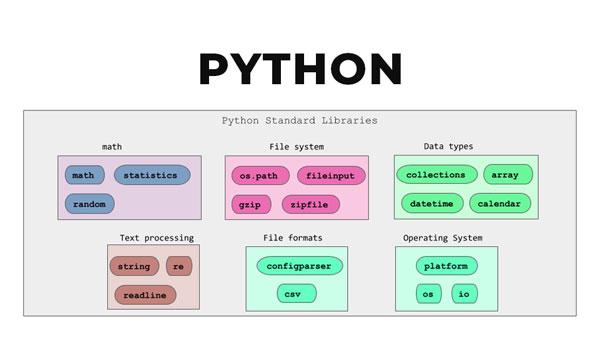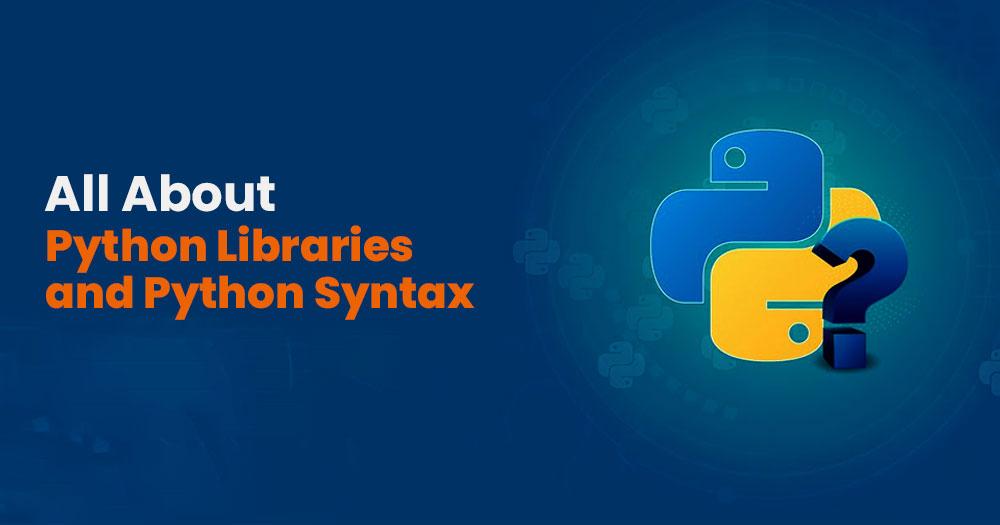Python libraries

The simplicity of Python has been attracting many developers to create new python libraries & Python Syntax for machine learning. Because of the vast collection of libraries, Python is becoming massively famous amongst machine learning experts.
Python Libraries & Python Syntax is one of the most famous and broadly used programming languages and has been replacing many programming languages in the industry for a long time.
There are many reasons why Python is famous among developers, and one of them is that it has a massive collection of Python Libraries & Python Syntax that users can work with.
Here are some of the fundamental reasons why Python is famous :
- Python has a massive collection of python libraries.
- Python is an early-level programming language because of its simplicity and easiness.
- From developing to deploying and maintaining, Python wants its developers to be more productive.
- Portability is another reason for the immense popularity of Python.
- Syntax Python is easy to learn other programming languages, and Python is of high level when we compare it to C, Java, and C++.python in only a few lines of code, make new applications.
You may also like to read about – Quick Introduction to Python Programming Language
Top 3 python libraries mentioned –
Matplotlib
Plotting numerical data is the responsibility of the python libraries. It’s for this reason that matplotlib is used in the analysis of data. matplotlib is an open-source library that plots with high-definition figures such as pie charts, scatterplots, boxplots, and graphs, among other things.
NumPy
NumPy is the most widely used open-source Python libraries package, focusing on mathematics and scientific computation. Numpy python libraries have built-in mathematical functions for convenient computation and facilitation of huge matrices and multidimensional data. You can use Numpy for many things involving linear algebra as an N-dimensional container for all data types. The NumPy Array Python object defines an N-dimensional array with rows and columns. With this, numpy could be used as a random number generator.
In Python libraries, NumPy is recommended over lists as it uses less memory, is faster, and is more convenient.
Images, sound waves, and other binary raw streams can be presented as a multidimensional array of absolute values using the NumPy interface for visualisation. Full-stack developers are familiar with Numpy to use these machine-learning python libraries.
Pandas
Pandas python libraries are open-source libraries licensed under the Berkeley Software Distribution (BSD). In the data science domain, this well-known python library is broadly used. Pandas are mainly used for analysis, manipulation, and cleaning of data, along other things. Pandas allow us to perform simple data modelling and analysis without swapping to another language like R.
About Python Programming language
- Python laid its foundation in the late 1980s. The question still of who develop the python language remains unnamed.
- The implementation of Python was started in December 1989 by Guido Van Rossum at CWI in the Netherlands. Guido van Rossum developed the python language.
- After the python language was developed by guided vas Rossum In February 1991, Guido Van Rossum published the code (labelled version 0.9.0) to alt. sources.
- In 1994, Python 1.0 released them with new characteristics like lambda, map, filter, and reduce. the
- Python 2.0 added new characteristics such as list comprehensions and garbage collection systems.
- On December 3, 2008, Python 3.0 (also called “Py3K”) was released. It was designed to rectify the fundamental flaw of the language.
- ABC programming language is said to be the predecessor of Python language, which was capable of Exception Handling and interfacing with the Amoeba Operating System.
- The following programming languages influence Python:
- ABC language.
- Modula-3
Python uses
Applications
Python can be for developing applications like web applications, graphic user interfaces based on applications, software development applications, scientific and numeric applications, network programming, Games and 3D applications and other business applications. Python uses an interactive interface and simple development of applications.
Multiple Programming paradigms
Python uses also used because it gives constant support to various programming paradigms and supports object-oriented and structured programming. Python has features that also assist multiple functional programming language concepts. Python uses for dynamic type systems and automatic memory management. Python language features and programming paradigms allow you to develop small and large applications. Python uses multiple programming paradigms that can be used for complex software applications.
Robust Standard Library
Python uses a robust standard library and has a vast and rich standard library for developing applications. Python uses the powerful standard library and makes the development use of Python over other languages. The standard library assists you use the various range of modules available for Python uses and assists you in adding functionality without writing any more code. To get information about different modules, c can refer to the documentation on the python uses of the standard library. While developing any web application, implementing web services, performing string operations and other usages like interface protocol, the standard library documentation helps.
Compatible with Major Platforms and Systems
Python uses of compatible with major platforms and systems is compatible leading platforms and systems which it is used majorly to develop applications. With the assistance of python interpreters, you can run python code on particular platforms and tools as it supports various operating systems. As Python uses is an interpreted high-level programming language, and it enables you to run the code on different platforms. Can execute the new and modified code without recompiling, and its impact can be monitored or checked. It means it’s okay to recompile the code after each change. This feature helps to save the development time of the developers.
Access of Database
Python uses to access the database easily. Python uses assists in customizing the interfaces of various databases like MySQL, Oracle, Microsoft SQL Server, PostgreSQL, and other databases. The Python used to access the database has an object database like Durus and ZODB. It is used for standard database API and is free and available for download.
What is syntax Python?
Syntax Python is a set of rules describing a language’s structure. The syntax of Python programming presents the rules or structure that controls the layout of the keywords, symbols, punctuation, and other tokens of Python programming. Without syntax, python programmers won’t be able to extract the meaning or semantics of a language.
Each human language, such as English, has syntax, which we learn through grammar. Syntax teaches us how to properly place each part of speech in the sentence to make it full of meaning. With syntax in Python, it is almost possible to make the interpreter understand what the programmer wants to convey to the computer through logical codes.
The importance of syntax Python:
As we all know, syntax Python is a high-level programming language. The syntax of Python improves code readability. Syntax python also makes sure that the four C’s of coding has proper implementation :
- Communication: what the syntax python program needs for executing by the interpreter.
- Code integration: how every statement is related to the other
- Consistency: how the code of syntax python gives meaning and a goal throughout the program
- Clarity: what the syntax python program needs for convey to the computer in the form of instructions
The concept behind developing specific conventions is to make the Python Libraries & Python Syntax of python code self-explanatory. If the code is self-explanatory and the code structure is known to the system software (Python interpreter), it can quickly parse each token into the syntax python meaningful representation.


